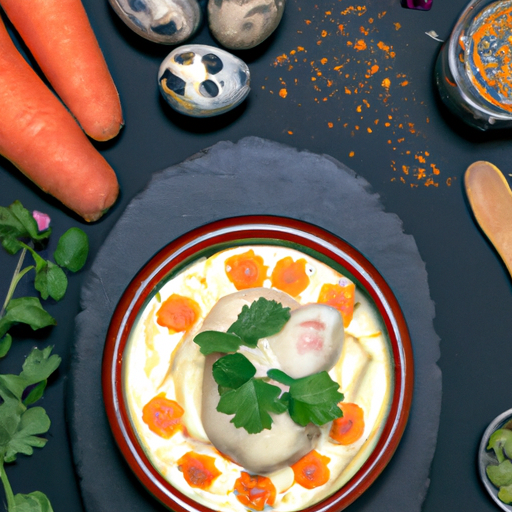
Have you ever wondered what new cuisine or type of food you and your loved ones haven’t discovered together yet? Well, look no further! Introducing “What’s A New Cuisine Or Type Of Food We Haven’t Experienced Together Yet?” This innovative product is designed to bring excitement and adventure to your dining experiences. With a wide range of cuisines and food types to choose from, you can embark on a culinary journey with your loved ones like never before. Try new flavors, experiment with different cooking techniques, and create unforgettable memories as you explore the world of food together. So, what are you waiting for? Let’s discover something deliciously new!

1. Fusion Cuisine
1.1 Origins of Fusion Cuisine
Fusion cuisine is a culinary style that combines elements from different culinary traditions to create innovative and unique dishes. The origins of fusion cuisine can be traced back to ancient times when different cultures began to interact through trade and exploration. Over the centuries, cultural exchanges and colonization further influenced the development of fusion cuisine.
One of the earliest examples of fusion cuisine can be seen in the Silk Road trade route, where ingredients and cooking techniques from various regions merged, resulting in the creation of dishes that combined flavors from different countries along the route. Similarly, throughout history, the movement of people and migration has led to the blending of culinary traditions.
1.2 Popular Fusion Food Examples
In recent years, fusion cuisine has gained popularity worldwide, with inventive chefs experimenting and pushing the boundaries of traditional cooking. One famous example of fusion cuisine is the California roll, which combines elements of Japanese sushi with local ingredients. This adaptation of traditional sushi was created in the 1960s in Los Angeles and played a significant role in introducing sushi to the Western palate.
Another well-known fusion dish is Korean BBQ tacos, which originated from the fusion of Mexican and Korean flavors. This delicious combination of tender, marinated meat wrapped in a soft tortilla with vibrant Korean toppings and sauces has become a favorite street food item in many cities.
1.3 Exploring New Fusion Combinations
With fusion cuisine constantly evolving, there are always new and exciting combinations to explore. Chefs are now experimenting with unique fusions, such as Indian-Mexican dishes that blend the bold flavors of Indian spices with the vibrant ingredients found in Mexican cuisine.
Other emerging fusion combinations include Scandinavian-Asian fusion, where traditional Nordic ingredients are paired with Asian cooking techniques and flavors, resulting in innovative and harmonious dishes. The possibilities for fusion cuisine are endless, allowing for an exciting exploration of diverse flavors and culinary techniques from around the world.
2. Molecular Gastronomy
2.1 Understanding Molecular Gastronomy
Molecular gastronomy is a scientific approach to cooking that explores the physical and chemical transformations of ingredients. It focuses on the study of the mechanisms behind cooking techniques and the sensory impact of food.
The concept of molecular gastronomy was popularized by French chemist Hervé This and Hungarian physicist Nicholas Kurti in the late 20th century. They sought to understand and explain the scientific processes that occur during cooking, such as the maillard reaction, sous vide cooking, and emulsion formation.
2.2 Techniques Used in Molecular Gastronomy
Molecular gastronomy employs various cutting-edge techniques to transform the textures and flavors of ingredients. Some commonly used techniques include spherification, where liquid ingredients are turned into gel-like spheres; foams created through the use of a whipped cream dispenser and nitrous oxide; and the use of liquid nitrogen to rapidly freeze ingredients, resulting in unique textures and presentations.
Another notable technique is sous vide cooking, which involves vacuum-sealing food and cooking it at precise temperatures for an extended period. This method ensures even cooking and enhanced flavors while preserving the natural juices and nutrients of the ingredients.
2.3 Innovative Molecular Gastronomy Dishes
Molecular gastronomy has revolutionized the culinary world by introducing innovative and visually stunning dishes. For example, one popular molecular gastronomy creation is the edible cocktail, where cocktails are transformed into solid or semi-solid forms, often resembling colorful capsules or pearls.
Additionally, chefs are utilizing molecular gastronomy techniques to reinvent classic dishes. For instance, foams created with innovative flavor combinations are used to enhance the taste and presentation of traditional desserts like crème brûlée or chocolate mousse.
The exploration of molecular gastronomy continues to captivate both chefs and diners alike, pushing the boundaries of traditional cooking methods and allowing for new culinary experiences.
3. Insects as Food
3.1 The Rise of Entomophagy
Entomophagy, the consumption of insects as food, has gained attention in recent years due to its potential as a sustainable and nutritious food source. While it may be uncommon in some Western cultures, entomophagy has been practiced for centuries in many parts of the world, particularly in Africa, Asia, and Latin America.
As the global population grows, the demand for protein-rich food sources increases. Insects provide an alternative protein source that requires significantly fewer resources, such as land and water, compared to traditional livestock. This makes them an environmentally friendly option and an attractive solution to combat food insecurity.
3.2 Health Benefits and Sustainability
Insects are highly nutritious, often containing high levels of protein, healthy fats, vitamins, and minerals. They can provide essential nutrients while being low in carbohydrates and cholesterol. Additionally, insects are environmentally sustainable, as they emit fewer greenhouse gases and require less feed, water, and space compared to traditional livestock.
Moreover, the consumption of insects can help diversify diets and reduce the reliance on resource-intensive livestock farming. Embracing entomophagy can be a step towards creating a more sustainable and resilient food system.
3.3 Exploring Insect-Based Dishes
Insect-based dishes are gaining traction with adventurous eaters and innovative chefs. They are being incorporated into various culinary creations, from protein-rich energy bars and pasta made from cricket flour to savory snacks seasoned with spices and flavors that complement the natural taste of insects.
Restaurants around the world are experimenting with insect-based dishes, showcasing the versatility and potential of these tiny creatures. For example, roasted crickets can add a crunchy texture to salads or stir-fries, while mealworms can be transformed into delectable protein-packed patties for burgers.
Exploring the diverse flavors and textures of insect-based dishes not only offers new culinary experiences but also supports sustainability and the development of a more resilient food system.
4. Plant-based Meat Alternatives
4.1 Plant-based Meat Market Growth
The demand for plant-based meat alternatives has skyrocketed in recent years. Consumers are increasingly seeking sustainable and ethical food choices that reduce their environmental footprint. Plant-based meat offers a viable solution to meet this demand by providing alternatives to traditional animal-based proteins.
Driven by innovations in food technology, the plant-based meat market has seen tremendous growth, with an expanding range of products available in grocery stores and restaurants. These products aim to replicate the taste, texture, and appearance of conventional meat, appealing to both vegetarians and flexitarians looking to reduce their meat consumption.
4.2 Types of Plant-based Meat Substitutes
Plant-based meat substitutes come in various forms, ranging from burgers and sausages to deli slices and ground “meat.” They are typically made from plant proteins, such as soy or wheat, and are often enhanced with other ingredients to mimic the taste and texture of meat. These alternatives can provide a similar cooking experience as traditional meat, allowing for easy incorporation into familiar recipes.
In addition to the well-known plant-based burger patties and sausages, innovative companies are now developing alternatives to seafood and even lab-grown meat. These advancements in plant-based meat technology offer exciting possibilities for the future of sustainable and ethical protein alternatives.
4.3 Creative Plant-based Meat Dishes
Cooking with plant-based meat alternatives opens up a world of creative possibilities in the kitchen. Vegetarian BBQ skewers featuring plant-based “chicken” or “beef” can be marinated in flavorful sauces and grilled to perfection, offering a delicious and sustainable option for outdoor gatherings.
Plant-based minced “meat” can be used as a filling for tacos, stuffed bell peppers, or vegetarian lasagna, providing a nutritious and tasty alternative to traditional meat-based dishes. The versatility of plant-based meats allows for endless culinary creativity and encourages the exploration of plant-forward cooking.

5. Alternative Grains
5.1 Introduction to Alternative Grains
Alternative grains, also known as ancient or heritage grains, are gaining popularity as a nutritious and sustainable alternative to traditional grains. These grains include varieties such as quinoa, amaranth, teff, and farro, which have been consumed for centuries in different cultures.
Alternative grains have unique flavors, textures, and nutritional profiles. They are often rich in fiber, protein, vitamins, and minerals. Incorporating alternative grains into your diet can provide a diverse range of nutrients and contribute to a healthy lifestyle.
5.2 Health Benefits of Alternative Grains
Alternative grains offer several health benefits when compared to refined grains. They are less processed and retain more of their natural nutrients, including antioxidants and phytochemicals. The higher fiber content in alternative grains promotes healthy digestion, helps regulate blood sugar levels, and supports heart health.
Moreover, alternative grains often have a lower glycemic index, making them a suitable choice for individuals managing diabetes or those looking to stabilize their blood sugar levels. The inclusion of alternative grains in one’s diet can contribute to improved overall health and well-being.
5.3 Delicious Dishes with Alternative Grains
Incorporating alternative grains into your meals opens up a world of culinary opportunities. For breakfast, you can experiment with quinoa or amaranth porridge topped with fresh fruits and nuts. These grains provide a nutritious and satisfying start to your day.
For lunch or dinner, explore the versatility of alternative grains by incorporating them into grain bowls, salads, or pilaf dishes. A salad made with farro, roasted vegetables, and a tangy dressing can be both nutritious and flavorful.
Alternative grains also lend themselves well to baking. You can try incorporating teff flour into bread or using quinoa flour in gluten-free baking recipes. The unique flavors and textures of these grains will add depth and complexity to your creations.
6. African Cuisine
6.1 Diverse Flavors of African Cuisine
African cuisine is a vibrant and diverse fusion of flavors, reflecting the continent’s rich cultural heritage and history. The cuisine varies widely across the continent, with each region boasting its unique culinary traditions and ingredients.
North African cuisine, influenced by Mediterranean flavors, features dishes such as couscous, tagines, and falafel. In West Africa, bold and spicy flavors dominate, with dishes like jollof rice, egusi soup, and plantain-based dishes. East African cuisine is known for its aromatic spices and flavorful stews, while Southern African cuisine incorporates indigenous ingredients like maize, millet, and meats such as game and ostrich.
6.2 Traditional African Dishes
Traditional African dishes are a testament to the continent’s culinary diversity and cultural heritage. Dishes like Ethiopian injera, a sourdough flatbread served with various stews and curries, or South African bobotie, a savory spiced meat dish topped with an egg-based custard, offer a taste of the region’s unique flavors.
Another iconic African dish is Nigerian jollof rice, a one-pot rice dish cooked with tomatoes, peppers, and a fragrant blend of spices. It is often served with grilled meats or fried plantains. These traditional dishes highlight the depth of flavor and creativity found in African cuisine.
6.3 Modern Interpretations of African Gastronomy
In recent years, African cuisine has gained recognition and influence in the global culinary scene. Chefs are weaving traditional African flavors into modern interpretations, creating exciting fusion dishes that appeal to a wider audience.
For example, West African flavors are being incorporated into gourmet burgers, with toppings like spicy peanut sauce or plantain chips adding a unique twist. East African spices and ingredients are finding their way into contemporary seafood dishes, offering a fusion of African and international culinary traditions.
As African cuisine continues to evolve and gain recognition, exploring modern interpretations allows for the celebration of both traditional and innovative flavors from the continent.

7. Southeast Asian Street Food
7.1 Vibrant Street Food Culture in Southeast Asia
Southeast Asia is famous for its vibrant street food culture, where bustling markets and street stalls offer an array of delicious and affordable dishes. From the aromatic flavors of Thailand to the rich spices of Malaysia and the unique blend of sweet, sour, and spicy in Vietnam, the street food in this region caters to all taste buds.
The streets come alive with the sizzle of stir-frying woks, the tantalizing aromas of grilled meats, and the vibrant colors of fresh tropical fruits. The street food experience in Southeast Asia is an adventure for the senses, providing a glimpse into the vibrant culinary heritage of the region.
7.2 Iconic Street Food Staples
Several iconic street food dishes have become staples in Southeast Asian cuisine. In Thailand, the fragrant and spicy pad Thai, a stir-fried noodle dish, is a must-try. The aromatic Vietnamese pho, a flavorful soup with rice noodles and tender beef or chicken, is another popular choice.
Malaysia is known for dishes like nasi lemak, a flavorful coconut rice dish served with sambal, fried anchovies, and peanuts. In Indonesia, sate skewers, grilled and served with peanut sauce, offer a delicious combination of smoky flavors and savory sauces.
7.3 Underrated Gems of Southeast Asian Street Food
While some street food dishes in Southeast Asia have gained international recognition, there are many underrated gems that deserve attention. For instance, in the Philippines, balut, a fertilized duck egg boiled and consumed with salt and vinegar, may be an acquired taste but offers a unique and authentic experience.
In Cambodia, num pang, a baguette sandwich filled with grilled meat, pickled vegetables, and fresh herbs, showcases the French and Southeast Asian influences in Cambodian cuisine. These underrated gems provide an opportunity for culinary exploration and a chance to discover lesser-known delights in Southeast Asian street food.
8. Native American Cuisine
8.1 Exploring Native American Culinary Heritage
Native American cuisine, also known as Indigenous cuisine, encompasses the diverse culinary traditions of the indigenous peoples of North and South America. It is a cuisine deeply rooted in tradition and reflects the close relationship between Native American cultures and the land.
Native American culinary heritage varies across different tribes and regions. From the indigenous peoples of the Southwest, known for their reliance on corn, beans, and squash, to the tribes of the Great Plains, where bison played a vital role in their diet, each region offers unique flavors and ingredients.
8.2 Traditional Native American Foods
Traditional Native American foods reflect the available local resources and the sustainable practices of Indigenous cultures. For example, fry bread, a popular staple in many tribes, is a deep-fried bread made from dough and typically served with savory or sweet toppings.
Another iconic dish is pemmican, a high-energy food made by combining dried meat, berries, and rendered fat. This nutritious and portable food source was a vital part of survival for many Indigenous peoples, particularly during long journeys and harsh winters.
8.3 Contemporary Native American Recipes
Contemporary Native American chefs and culinary experts are working to preserve and celebrate their culinary heritage while infusing it with modern techniques and flavors. They are creating innovative and vibrant dishes that showcase the rich history and culture of Indigenous cuisine.
For example, dishes like cedar-planked salmon, inspired by the Pacific Northwest tribes, highlight the use of local ingredients and traditional cooking methods. Bison stew, prepared with root vegetables and aromatic herbs, pays homage to the Great Plains tribes’ traditional way of utilizing bison.
Exploring contemporary Native American recipes not only provides a culinary experience but also fosters a deeper understanding and appreciation for the rich cultural heritage of Indigenous peoples.

9. Artisanal Ice Cream
9.1 The Craft of Making Artisanal Ice Cream
Artisanal ice cream is a labor of love. Crafted in small batches, it is made with high-quality ingredients and a dedication to traditional, time-honored techniques. Artisanal ice cream makers prioritize flavor, texture, and creativity to deliver a truly exceptional frozen dessert experience.
Unlike commercial ice cream, artisanal ice cream often features unique and unconventional flavor combinations, incorporating seasonal fruits, spices, and even savory ingredients. The process of making artisanal ice cream involves careful attention to detail, from sourcing the finest ingredients to slow-churning the ice cream to achieve a creamier and denser texture.
9.2 Unique and Unconventional Ice Cream Flavors
One of the joys of artisanal ice cream is the wide range of flavors available, including many that you may have never encountered before. From exotic fruits like lychee and durian to unexpected combinations like lavender honey or olive oil and sea salt, artisanal ice cream offers a delightful adventure for your taste buds.
Creative flavors go hand in hand with artisanal ice cream. Think lavender and blackberry, Thai tea with coconut milk, or even bacon maple crunch. These unique flavors push the boundaries of traditional ice cream and showcase the imagination and skill of artisanal ice cream makers.
9.3 Homemade Ice Cream Recipes
Creating your own artisanal ice cream at home allows for a truly personalized frozen treat experience. With the right ingredients and a little creativity, you can explore various flavor combinations and experiment with textures.
For a classic base, a simple vanilla ice cream made with real vanilla beans and high-quality cream is a great starting point. From there, you can add your favorite mix-ins, such as fresh fruit, chocolate chunks, or crunchy nuts, to create a flavor profile that suits your preferences.
Homemade ice cream recipes are also an excellent opportunity to try unconventional flavors. Whether it’s a matcha green tea ice cream or a silky roasted banana and salted caramel creation, indulging in homemade artisanal ice cream allows for endless possibilities and a truly delightful dessert experience.
10. Peruvian Cuisine
10.1 Discovering the Diverse Flavors of Peru
Peruvian cuisine is a flavorful and diverse fusion of multiple cultural influences, including Indigenous, Spanish, African, and Asian. The country’s unique geography, which spans the Pacific coast, the Andean mountains, and the Amazon rainforest, contributes to the rich and varied ingredients found in traditional Peruvian dishes.
Peru’s culinary heritage is known for its diversity, incorporating ingredients such as potatoes, corn, quinoa, aji peppers, and an abundance of seafood. These ingredients form the foundation of iconic dishes that showcase the vibrant flavors and cultural history of the region.
10.2 Iconic Peruvian Dishes
Peruvian cuisine offers a myriad of iconic dishes that have gained popularity worldwide. Ceviche, a dish made with fresh raw fish or seafood marinated in lime juice and seasoned with onions and chili peppers, is a staple of Peruvian coastal cuisine. Its refreshing flavors and bright acidity make it a popular choice for seafood lovers.
Lomo saltado, a stir-fry made with marinated beef, onions, tomatoes, and served with rice and potatoes, exemplifies the fusion of Peruvian and Chinese culinary traditions. The dish showcases the influence of Chinese immigrants on Peruvian cuisine, combining bold flavors with traditional ingredients.
10.3 Experiencing Authentic Peruvian Ingredients
Exploring Peruvian cuisine offers a chance to experience unique ingredients that are intrinsically linked to the country’s culinary heritage. For example, quinoa, a protein-rich grain that originated from the Andes, can be incorporated into salads, soups, or even desserts for a healthy and flavorful twist.
Aji amarillo, a vibrant yellow chili pepper, is a staple in Peruvian cooking and adds a distinctive and slightly fruity flavor to dishes. It can be used in sauces, marinades, or as a condiment to enhance the flavors of various Peruvian dishes.
Experiencing authentic Peruvian ingredients allows for a deeper understanding and appreciation of the country’s culinary traditions and cultural heritage.
In conclusion, the world of food is an ever-evolving landscape, continuously shaped by our curiosity, creativity, and diverse culinary traditions. From fusion cuisine to molecular gastronomy, from entomophagy to artisanal ice cream, and from unique grains to regional cuisines, there are countless opportunities to explore new flavors and expand our culinary horizons. So, embark on a gastronomic adventure, and let your taste buds guide you as you delve into the diverse and exciting world of food.




